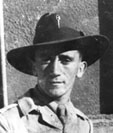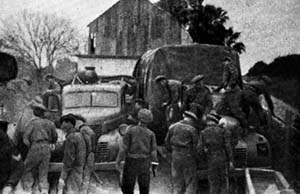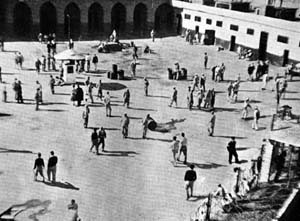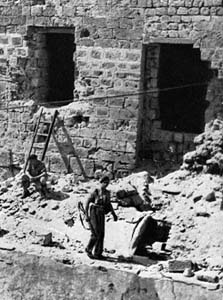

 Eitan Livni |
Amichai Paglin (Gidi), chief operations officer, toured Acre disguised as an Arab, and after thorough scrutiny of the area, concluded that a break-in was indeed possible. After discussions at headquarters, Livni received a letter stating that it was possible to breach the wall from outside, but that the success of the operation depended on the ability of the prisoners to reach the south wall on their own. To that end, explosives, detonators and a fuse were smuggled into the jail by the parents of prisoners, who were permitted to bring their sons delicacies, such as jam, oil, and fruit. The explosives were smuggled in inside a can, under a thick layer of jam. A British sergeant opened the can and examined its contents. When he poked inside, he felt hard lumps (in fact gelignite), but accepted the story that the jam had not gelled properly. The detonators and the fuse were concealed in the false bottom of a container of oil, which was also thoroughly examined. The sergeant poked in a long stick to examine the level of the oil, but since the fuse and the detonators were less than one centimeter thick, he did not notice the false bottom.
 Dov Cohen (Shimshon) |

After the fighters had been assigned to their units, they were all given an 'English' haircut. The next day, they were taken to Shuni, a former Crusader fortress (between Binyamina and Zichron Yaakov), then serving as a settlement for the Irgun supporters. Twenty of them wore British Engineering Corps uniforms, while three were dressed as Arabs. After they had been briefed and armed, they set out in a convoy of vehicles including a 3-ton military truck, two military vans with British camouflage colors, and two civilian vans. The convoy was headed by the command jeep, and Shimshon, dressed as a be-medalled British captain, sat beside the driver.
 Avshalom Haviv |
An additional three-man squad, disguised as Arabs, was positioned north of Acre, and when the operation began they fired a mortar at the nearby army camp. The command jeep halted at the gas station at the entrance to the new town, laid anti-vehicle mines and set fire to the station.
While these units were taking up positions outside the fortress, the plan was being put into effect inside the prison. At 3pm, the doors of the cells were opened for afternoon exercise. Those prisoners who were not scheduled to escape went down to the courtyard to create a diversion, while the escapees remained in their cells. They were divided into three groups, each in a separate cell.
At 4:22 pm. a loud explosion shook the entire area, as the wall of the fortress was blasted open.
The first group of escapees leapt out of their cell and ran down the corridor towards the breach in the wall. They had to push their way through a crowd of Arab prisoners who ran out of their cells in panic and blocked their path. The first escapee, Michael Ashbel, attached explosive charges to the locks barring the gate of the corridor, and lit the fuse. There was an explosion, and the gate blew open. The second gate was blown open in the same way, opening the route to freedom. At that moment, the second group went into action; they created an obstruction by igniting kerosene mixed with oil. The ensuing fire blocked the escape route, so that the guards could not reach it. The third group threw grenades at the guards on the roof, who fled. In the confusion created by the explosion, the gunfire and the fire, 41 prisoners made their way to freedom.
The first group of escapees boarded a van and drove off, but the driver mistakenly drove towards Haifa, instead of Mount Napoleon. On the shore, a group of British soldiers who had been bathing in the sea opened fire on them. The driver tried to turn back, but hit the wall of the cemetery and the van overturned. The escapees ran towards a gas station, the soldiers pursuing them. Dov Cohen fired his Bren at them, but was mowed down by a volley of 17 bullets. Zalman Lifshitz, at his side, was also killed. When the firing stopped, five of the first group of 13 escapees were dead, six injured and only two were unscathed. The survivors were returned to jail.

Affter-noon walk of Acre prisnors
Acre prison's wall after the blowing up
 Yaakov Weiss |
The remaining escapees and members of the strike force in the truck and the second van escaped safely. They reached Kibbutz Dalia, abandoned their vehicles, and made their way on foot to Binyamina. There they were given refuge in the Nahlat Jabotinsky quarter and the following morning were dispersed throughout the country to pre-designated hiding places.
Haim Appelbaum of Lehi, wounded during the retreat, succeeded in boarding the last van, but died soon after. His body was left in the vehicle, and members of Kibbutz Dalia conveyed it to the burial society in Haifa the following day.
To conclude, 27 inmates succeeded in escaping (20 from the Irgun and seven from Lehi). Nine fighters were killed in clashes with the British army; six escapees and three members of the Fighting Force. Eight escapees, some of them injured, were caught and returned to jail. Also arrested were five of the attackers who did not make it back to base. The Arab prisoners took advantage of the commotion, and 182 of them escaped as well.
Despite the heavy toll in human lives, the action was described by foreign journalists as 'the greatest jail break in history'. The London Ha'aretz correspondent wrote on May 5:
The New York Herald Tribune wrote that the underground had carried out 'an ambitious mission, their most challenging so far, in perfect fashion'.
In the House of Commons, Oliver Stanley asked what action His Majesty's Government was planning to take 'in light of the events at Acre prison which had reduced British prestige to a nadir'.

The attack on Acre jail has been seen here as a serious blow to British prestige... Military circles described the attack as a strategic masterpiece.
 Meir Nakar |
The other two, Michaeli and Ostrowicz, were captured, unarmed, at some distance from the jail. Since there was a chance of saving them from the death penalty, the Irgun General Headquarters decided to conduct a proper defence procedure. The counsel for the defence succeeded in producing documents proving that the two were minors, and the court sentenced them to life imprisonment.
next: The Gallows